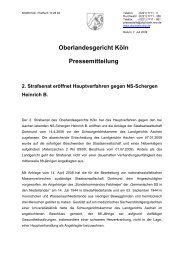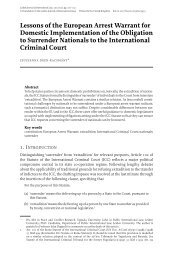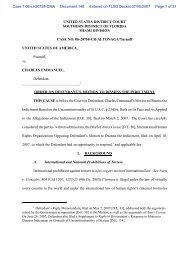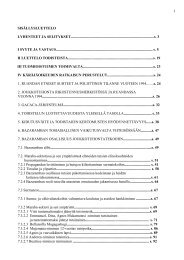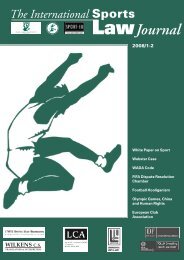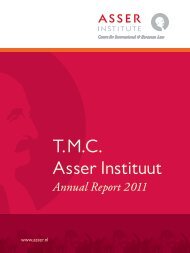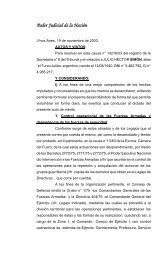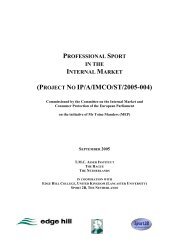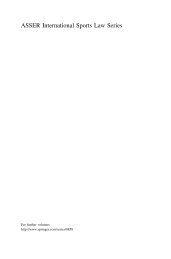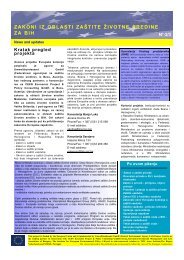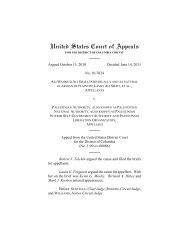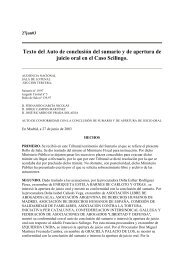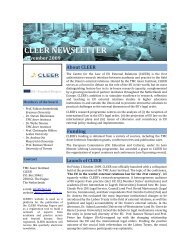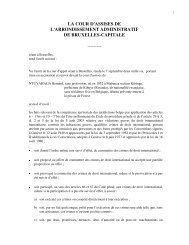Islj 2009 3-4 - TMC Asser Instituut
Islj 2009 3-4 - TMC Asser Instituut
Islj 2009 3-4 - TMC Asser Instituut
You also want an ePaper? Increase the reach of your titles
YUMPU automatically turns print PDFs into web optimized ePapers that Google loves.
To secure the appreciation of CAS it was needed to improve its<br />
integrity, which was achieved in 1994 with the signing of the so-called<br />
Paris Agreement. It included the installation of an extra body between<br />
the IOC and CAS, dealing with ordinary arbitration and also in<br />
charge of the CAS administrative and financial matters, so as to distance<br />
and guard CAS sufficiently against IOC interference.<br />
This newly installed entity is the International Council of<br />
Arbitration for Sports (ICAS). The preamble of the Paris Agreement<br />
reads as follows: “with the aim of facilitating the resolution of disputes<br />
in the field of sport, an arbitration institution entitled the “Court of<br />
Arbitration for Sport” (hereinafter the CAS) has been created, and that,<br />
with the aim of ensuring the protection of the rights of the parties before<br />
the CAS and the absolute independence of this institution, the parties<br />
have decided by mutual agreement to create a Foundation for international<br />
sports-related arbitration, called the “International Council of<br />
Arbitration for Sport” (hereinafter the ICAS), under the aegis of which<br />
the CAS will henceforth be placed”. 61<br />
The ICAS and the CAS together, have over 300 arbitrators from 55<br />
countries, chosen for their specialist knowledge of arbitration and<br />
sports law. CAS tribunals try an average of 200 cases annually, 62 apply<br />
Swiss law and most of the time following the stare decisis principle 63 ,<br />
observing previous decisions in similar cases. However, CAS tribunals<br />
frequently also decide ex aequo et bono. 64 In addition, both the ICAS<br />
and the CAS take into account the fundamental doctrines of international<br />
Sports Law, viz. Access - Fair play - Olympism - Commerce 65 .<br />
4.3. Legal options in an eventual dispute with the IOC<br />
The basic rule is that all parties recognized by the IOC have accepted<br />
the Olympic Charter, of which Rule 15.4 declares the CAS to be the<br />
only instance to hear disputes. Both institutes are operating under the<br />
Code of Sports-related Arbitration. Among other information, this<br />
Code indicates that the CAS has two instances, the Ordinary Division<br />
and the Appeal Arbitration Division. Based on the CAS Rule R45 parties<br />
to a dispute can decide to the applicable law and in absence CAS<br />
may apply Swiss law. 66 It is also mentioned that in rare instances, CAS<br />
decisions can be appealed to the Swiss Federal Tribunal. In addition<br />
to the described courts, the CAS also operates Ad Hoc Panels at<br />
Olympic sites. Since these are not relevant to my Thesis, I further disregard<br />
them.<br />
In the event that an eligible party wants to file a case at the CAS, it<br />
is not compulsory to hire a lawyer for this 67 . However, from reports<br />
and listening to a few who have been in procedures at this tribunal, it<br />
is advisable to have a lawyer because the knowledge of arbitration and<br />
Sports Law, a non codified law system, to great extend related to<br />
International Law, referred to as Lex Sportiva, considered a lex specialis.<br />
68 Its principles contain among others the principles of good<br />
faith and fair play, considered firm doctrines in sports globally. The<br />
more arbitrational style of the CAS courts calls for specific expertise,<br />
most regular lawyers do not master.<br />
The CSF is not yet a party to the Olympic Charter, so it does not<br />
fall under the sphere of action of Rule 15.4, and as a consequence it<br />
cannot unwillingly be bound by the Charter. However, in accordance<br />
61 http://www.tas-cas.org/en/<br />
infogenerales.asp/4-3-237-1011-4-1-1/<br />
5-0-1011-3-0-0/.<br />
62 www.faqs.org/sports-science/<br />
Ce-Do/Court-of-Arbitration-for-Sport-<br />
CAS.html.<br />
63 I. Blackshaw. International Sports Law<br />
Journal, Volume 1-2 (2008), p. 20.<br />
64 Ex aequo et bono in Latin means<br />
“according to the right and good “ also<br />
“from equity and conscience”, it is a<br />
legal term often used in arbitration , it<br />
refers to the room to arbitrators for dispense<br />
with consideration of the law and<br />
to decide on solely what they consider to<br />
be fair and equitable in a case.<br />
65 O. Olatawura. International Sports Law<br />
Journal. Volume 3-4 (2008), p.130-143.<br />
66 www.tas-cas.org/d2wfiles/document/<br />
281/5048/0/<br />
3.1%20CodeEngnov2004.pdf<br />
67 www.tas-cas.org/d2wfiles/document/<br />
281/5048/0/3.1%20CodeEngnov2004.pdf<br />
68 O. Olatawura. International Sports Law<br />
Journal. Volume 3-4 (2008), p.130-143.<br />
69 www.tas-cas.org/d2wfiles/document/<br />
281/5048/0/3.1%20CodeEngnov2004.pdf<br />
70C.F. Amerasinghe. Principles of the institutional<br />
law of international organization<br />
(1996) , p. 226-229.<br />
71 en.wikipedia.org/wiki/<br />
List_of_active_autonomist_and_<br />
secessionist_movements.<br />
with the CAS Procedural Rule R27 69 the CSF has the option to file<br />
the case at CAS, which is a far less costly institute than Federal Swiss<br />
Courts. Note that the CAS is an arbitration tribunal, applying internationally<br />
accepted principles of arbitration, constitutionally available<br />
to hear and decide every sports related dispute presented to them,<br />
provided the parties comply with the regulations of the Code of<br />
Sports Related Arbitration.<br />
The other option is to file the case at the Swiss Federal Court, following<br />
the lex loci delicti commissi principle of international private<br />
law 70 , which means the jurisdiction where the conflict arises ( if the<br />
CSF request will be denied, this will be Lausanne - Switzerland ) is<br />
indicative for the choice of forum and applicable law. It must be clear<br />
that based on this international law principle mentioned, it is impossible<br />
for the CSF to take the case to our Court in Curaçao upon rejection<br />
by the IOC.<br />
Churandy Martina, after his 200 mtr race in Beijing in 2008.<br />
Churandy is from Curaçao, affiliated to and trained by a CSF member<br />
federation. It is time his chest reads Curaçao.<br />
Or will he be forced to carry the Stateless flag ??<br />
5. Rule 31.1 and our Autonomy<br />
The previous information contained the more formal frame of the<br />
Olympic organization and has mentioned the available legal provisions<br />
in the specific case of IOC recognition denial. In anticipation of<br />
a possible arbitration or lawsuit procedure by the CSF, it was also<br />
emphasized that as early as the initial application for recognition,<br />
experienced legal support will be crucial.<br />
In this Section I will mention why Charter Rule 31.1 was included<br />
in the Charter and elaborate on the conceptions independent and<br />
autonomous state as described in international public law literature<br />
and customaries, explaining also how little difference there is today<br />
between these two conceptions.<br />
5.1. Originating background of Rule 31.1<br />
This Rule has been altered in 1996 following years of increasing political<br />
pressure on IOC regarding several requests for recognition. Until<br />
that date, recognition was not linked to the status of a country as can<br />
be seen on the IOC answer hereunder. According to verbal information<br />
received from officials of the IOC Legal Affairs Department, the<br />
IOC was confronted with a number of conflicting requests in the<br />
early 80’s. The majority of these applications came from rebellious<br />
groups occupying part of an existing country trying to declare a state<br />
and looking around for supportive recognition by other countries.<br />
These efforts of state recognition appeared not so easy and as a result,<br />
many of these separation movements creatively thought to have found<br />
a better way by applying for Olympic recognition. Among them were<br />
well-known groups like ETA (Basque - Spain) , Polisario (West-Sahara/<br />
Morocco), IRA (North Ireland - Great Britain), FARC (Colombia),<br />
and many other groups from all over the world. 71<br />
In addition, there were also countries and cities which declared<br />
themselves independent, dissociating from their authentic country.<br />
Most were, and some still are, in the middle of tensional conflicts with<br />
their country of origin, among others: Taiwan and Macau (both<br />
China); a number of new Soviet countries; Yugoslavia fractions; other<br />
former Eastern European countries with internal separation conflicts<br />
and the PLO in the Middle East. I have contacted IOC on the origin<br />
of Rule 31.1 and received the following answer. (see page 48)<br />
IOC had to adjust its regulations otherwise the organization would<br />
largely be misused by several of these parties, de jure not in compliance<br />
with the internationally accepted standards of statehood. I have<br />
tried to get my hand on the preparatory notes of the proposal for the<br />
alteration of Rule 34 , renumbered to 31.1, but was unsuccessful.<br />
On page 48 at the right is the text of page 5 of the minutes of<br />
Session 105th of 1996 held in Atlanta.The additional remark of the<br />
Chairman of the IOC Legal Commission Judge H.E. Kéba Mbaye<br />
gives a good indication that political struggles were influential in the<br />
altering.<br />
A RT I C L E S<br />
<strong>2009</strong>/3-4 53



